How to Grow Pineapple Plants from Tops: A Step-by-Step Home Gardening Guide
- April 4, 2024
- 0 comment
Pineapples, with their sweet, tropical flavor, have been a favorite for many. Interestingly, the crown of a pineapple holds a secret – it can grow into a new plant. This guide will show you how to transform the top of a pineapple into a flourishing houseplant or garden addition.

List on How to Grow Pineapple Plants from Tops
- Materials Needed
- Select and Prep Your Pineapple
- Rooting in Water
- Planting
- Care and Maintenance
- Patience is Key
Materials Needed
- A ripe pineapple
- A sharp knife
- A small bowl of water
- A pot with drainage holes
- Potting soil suited for succulents or cacti
- A sunny location (either indoors or outdoors)
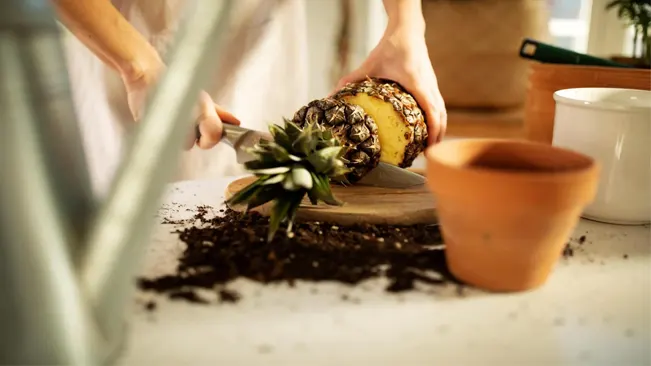
Select and Prep Your Pineapple
Selecting Your Pineapple
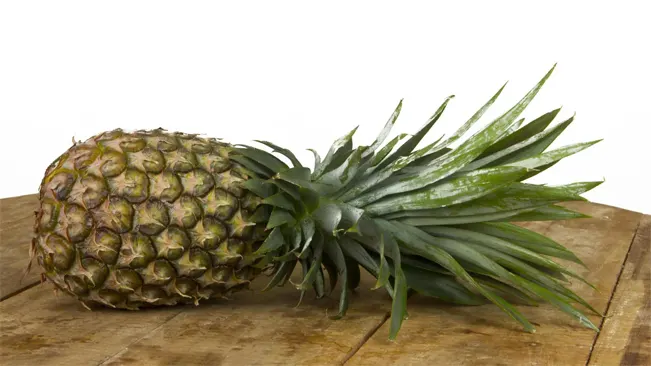
- Look for Freshness: A good candidate for planting is a fresh pineapple. The leaves should be a vibrant green without signs of yellowing or browning, which can indicate overripening or poor health.
- Firmness Matters: The body of the pineapple should feel firm to the touch. A soft body may mean the fruit is overripe, which can affect the viability of the crown for planting.
- Check the Leaves: Gently tug on the leaves. They should be firmly attached, indicating that the pineapple is healthy and not overly ripe.
Preparing the Pineapple Top
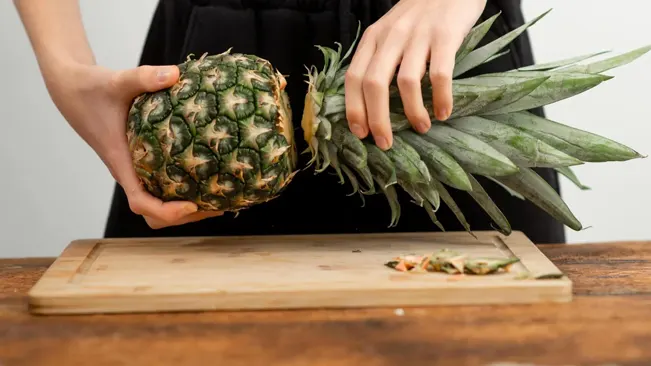
- Removing the Crown: You can twist off the top of the pineapple or use a sharp knife to cut it off. If you’re cutting, try to include about an inch of the fruit’s crown with the leaves.
- Twisting: Twisting off the crown can be easier and helps ensure a clean break, which is beneficial for rooting.
- Cutting: If you choose to cut, do so cleanly around the circumference of the pineapple, about an inch below the leafy top.
- Cleaning the Crown: Once removed, you need to clean and prepare the crown for rooting.
- Remove Lower Leaves: Peel off several layers of the lower leaves to expose the stem beneath. This area is where the roots will emerge. Removing about an inch of the lower leaves is typically sufficient.
- Drying the Crown: Let the crown dry out for a day or two. This process helps to heal the cut and reduce the risk of rot when you start the rooting process.
- Inspect for Pests: Make sure there are no small insects or pests in the leaf axils as these can harm the plant during its growth.
- The Right Cut: If you’re cutting the crown, make sure the cut is horizontal and even. An uneven cut can lead to uneven rooting and growth.
Rooting in Water
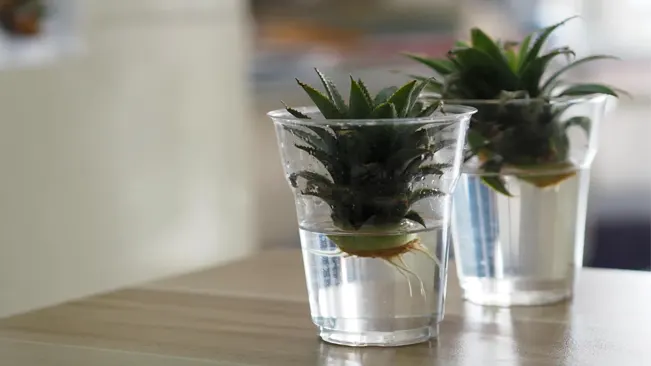
- Preparation of Pineapple Top
- After separating the top of the pineapple, ensure that about 1-2 inches of the lower leaves are removed to expose the stem. This exposed stem is where the roots will develop. Allow the cut end to dry for a few days to form a callous, reducing the risk of rot when submerged in water.
- Selecting the Right Container
- Use a small bowl or jar that can comfortably hold the pineapple top. The container should be stable and not too wide, to support the pineapple top without letting it topple over. Ensure that the exposed stem can be submerged in water.
- Submerging the Stem
- Place the pineapple top in the container, submerging the exposed stem in water. It’s crucial to submerge only the stem and not the leaves. If the leaves are submerged, they may rot.
- Water Quality and Change Frequency
- Use clean, fresh water to avoid any contaminants. It’s advisable to change the water every 2-3 days. This practice prevents the growth of mold and bacteria and ensures that the water remains fresh, enhancing root growth.
- Ideal Location and Temperature
- Place the container in a warm, sunny spot. Pineapples thrive in bright, indirect sunlight and warm temperatures. The ideal temperature range for rooting a pineapple top is between 68°F to 86°F (20°C to 30°C).
- Monitoring Root Growth
- Root formation typically begins within 2-3 weeks. You should notice small, white roots emerging from the base of the stem. Patience is key here; sometimes it may take longer for roots to appear.
Planting
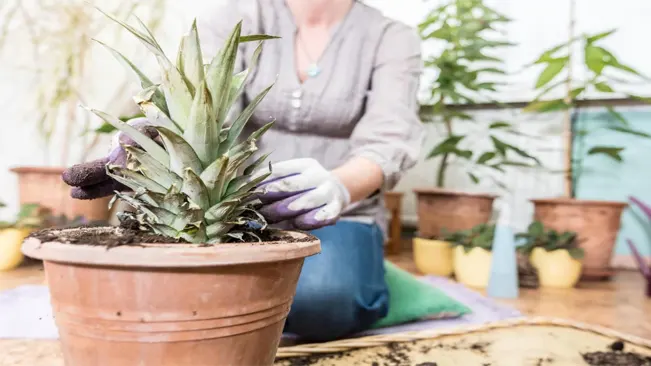
Choosing the Right Pot
- Size: Select a pot that is moderately sized – about 6 to 8 inches in diameter. This ensures enough room for the initial root growth.
- Material: You can use pots made of plastic, terracotta, or ceramic. Ensure they have drainage holes to prevent waterlogging.
Soil Requirements
- Type: A well-draining potting mix is essential. Use a mix formulated for cacti and succulents, which typically includes components like perlite, sand, and organic matter, providing the right balance for drainage and nutrient retention.
- pH Level: Pineapples prefer slightly acidic to neutral soil, with a pH range of 5.5 to 7.0.
Planting Process
- Preparation: Before planting, moisten the potting mix slightly. It should be damp but not soggy.
- Planting Depth: Plant the pineapple top so that the base of the leaves is just above the soil line. The rooted stem (about an inch) should be buried in the soil.
- Soil Firmness: Gently firm the soil around the base of the pineapple top. This helps in establishing contact between the roots and the soil but avoids compacting the soil too much, as this can hinder root growth.
- Watering After Planting: Water the plant lightly after planting. The goal is to settle the soil around the roots and provide moisture without overwatering.
Initial Positioning
- Light: Place the pot in a bright, indirect light setting. Avoid direct sunlight immediately after planting, as it can stress the plant.
- Temperature: Maintain a temperature between 65°F to 85°F (18°C to 29°C). Avoid placing the plant in drafty areas or near heat/AC vents.
Care and Maintenance
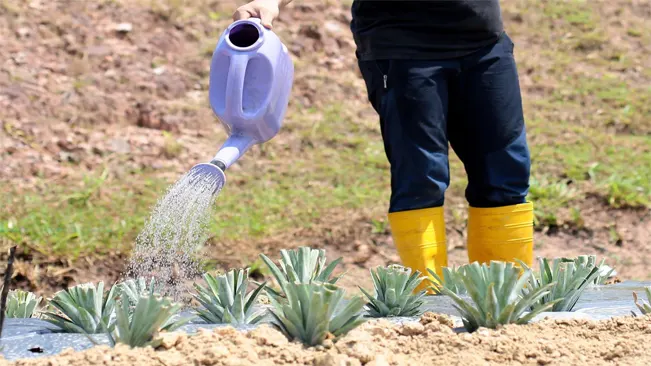
Watering
- Frequency: Pineapple plants need consistent moisture but do not like to be waterlogged. The key is to water them when the top inch of the soil feels dry to the touch. This might mean watering once a week, but the exact frequency depends on factors like humidity, temperature, and sunlight exposure.
- Technique: When you water, do it thoroughly so that the water reaches the roots. Avoid getting water on the leaves as this can promote rot.
- Adjustments: In winter or cooler weather, reduce watering since the plant will use less water.
Light Requirements
- Sunlight: Pineapple plants require bright, indirect sunlight. Ideally, they should receive about 6-8 hours of light daily.
- Indoor Placement: If you’re growing your pineapple indoors, place it near a south-facing window. If the light is too intense, use a sheer curtain to diffuse it.
- Outdoor Placement: In an outdoor setting, choose a spot where it will be protected from the harsh afternoon sun. Morning sun and partial afternoon shade are ideal.
Temperature and Humidity
- Ideal Temperature: Pineapples thrive in temperatures between 65°F and 90°F (18°C and 32°C). They are tropical plants and sensitive to cold.
- Winter Care: If outdoor temperatures drop below 60°F (15°C), it’s essential to bring the plant indoors to avoid cold damage.
- Humidity: These plants prefer high humidity. If you’re growing a pineapple indoors where the air is dry, consider using a humidifier or placing a water tray near the plant.
Patience is Key
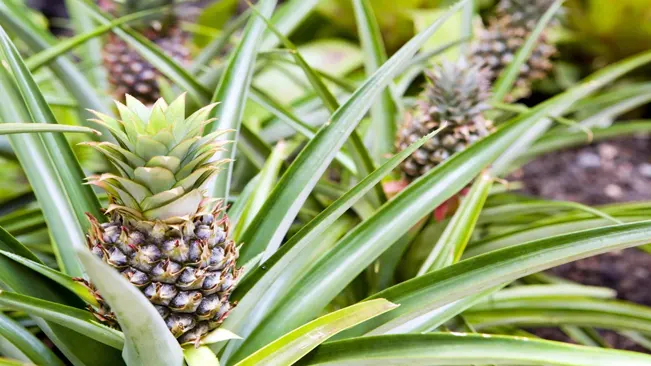
Understanding the Growth Timeline
- Root Development (2-3 weeks): After preparing the top, roots begin to develop when it’s placed in water. This process typically takes about 2 to 3 weeks. It’s crucial during this phase to change the water regularly to prevent rot and to provide a warm, bright environment to encourage root growth.
- Initial Planting and Establishment (6 months): Once the roots are about an inch long, the pineapple top is ready to be planted in soil. The first six months are critical for the plant to establish itself. During this period, the focus is on developing a strong root system and healthy foliage. Regular watering and good light are essential, but be cautious of overwatering, which can cause root rot.
- Vegetative Growth Phase (1-2 years): After establishment, the pineapple plant enters a vegetative growth phase, where it focuses on leaf development. This phase can last for 1 to 2 years. During this time, the plant requires consistent care – adequate sunlight, proper watering, and occasional feeding with a balanced fertilizer.
- Maturity and Flowering (2-3 years): It takes about 2 to 3 years from the time you plant the top for a pineapple plant to mature enough to flower and produce fruit. The flowering phase is triggered by environmental factors such as temperature and daylight hours. In some cases, gardeners use ethylene gas (naturally produced by apples) to encourage flowering.
Tips for Successful Growth
- Consistent Care: Regularly check the soil moisture and ensure the plant receives enough sunlight. Avoid drastic changes in the plant’s environment.
- Observation: Watch for signs of growth and health. New leaf growth is a good indicator that your plant is thriving.
- Patience: Understand that growing a pineapple is a slow process. The reward of a home-grown pineapple is worth the wait.
Related Growing Guides:
Conclusion
Planting the top of a pineapple is a rewarding and eco-friendly project. Not only does it reduce food waste, but it also adds a tropical flair to your home or garden. With care and patience, you’ll be able to watch your pineapple crown transform into a fruit-bearing plant.
FAQs (Frequently Asked Questions)
- What type of pineapple should I choose for planting?
- Choose a fresh pineapple with green, healthy leaves and a firm body. The healthier the pineapple, the better the chance of it rooting successfully.
- Choose a fresh pineapple with green, healthy leaves and a firm body. The healthier the pineapple, the better the chance of it rooting successfully.
- How do I prepare the pineapple top for planting?
- Twist or cut off the top of the pineapple. Remove the lower leaves to expose about an inch of the stem. This area is where the roots will grow.
- Twist or cut off the top of the pineapple. Remove the lower leaves to expose about an inch of the stem. This area is where the roots will grow.
- Do I need to dry the pineapple top before planting?
- Yes, it’s advisable to let the pineapple top dry for a few days to allow the cut end to callous over, which reduces the risk of rot.
- Yes, it’s advisable to let the pineapple top dry for a few days to allow the cut end to callous over, which reduces the risk of rot.
- How long does it take for roots to form in water?
- It usually takes about 2-3 weeks for roots to start forming when the base is submerged in water.
- It usually takes about 2-3 weeks for roots to start forming when the base is submerged in water.
- What type of soil is best for planting a pineapple top?
- Use a well-draining soil mix, ideally one formulated for succulents or cacti, as it provides the right balance of drainage and moisture retention.
- Use a well-draining soil mix, ideally one formulated for succulents or cacti, as it provides the right balance of drainage and moisture retention.
- How much sunlight does a pineapple plant need?
- Pineapple plants thrive in bright, indirect sunlight. If you’re growing it indoors, place it near a window that gets plenty of light.
- Pineapple plants thrive in bright, indirect sunlight. If you’re growing it indoors, place it near a window that gets plenty of light.
- How often should I water my pineapple plant?
- Water the plant when the top inch of soil feels dry. Pineapples prefer a balance – not too wet and not too dry.
- Water the plant when the top inch of soil feels dry. Pineapples prefer a balance – not too wet and not too dry.
- Can I plant a pineapple top outside?
- Yes, but they are best suited for warm, tropical climates. If temperatures drop below 60°F (15°C), the plant should be brought indoors.
- Yes, but they are best suited for warm, tropical climates. If temperatures drop below 60°F (15°C), the plant should be brought indoors.
- How long does it take for a pineapple plant to produce fruit?
- It can take 2-3 years for a pineapple plant grown from a top to mature and produce fruit. Patience is key!
- It can take 2-3 years for a pineapple plant grown from a top to mature and produce fruit. Patience is key!
- Can I grow a pineapple plant in a pot?
- Absolutely! In fact, growing a pineapple in a pot is ideal, especially if you need to move it indoors during colder months.

Kristine Moore
Forestry AuthorI'm Kristine Moore, a seasoned garden landscaping professional with over 30 years of experience. My extensive career has been dedicated to transforming outdoor spaces into stunning, sustainable landscapes. With a deep understanding of horticulture, design principles, and environmental stewardship, I have become a respected figure in the field, known for creating harmonious, visually appealing, and eco-friendly gardens. My commitment to excellence and continuous learning in landscaping trends and techniques has solidified my reputation as an expert in garden design and implementation.













Leave your comment